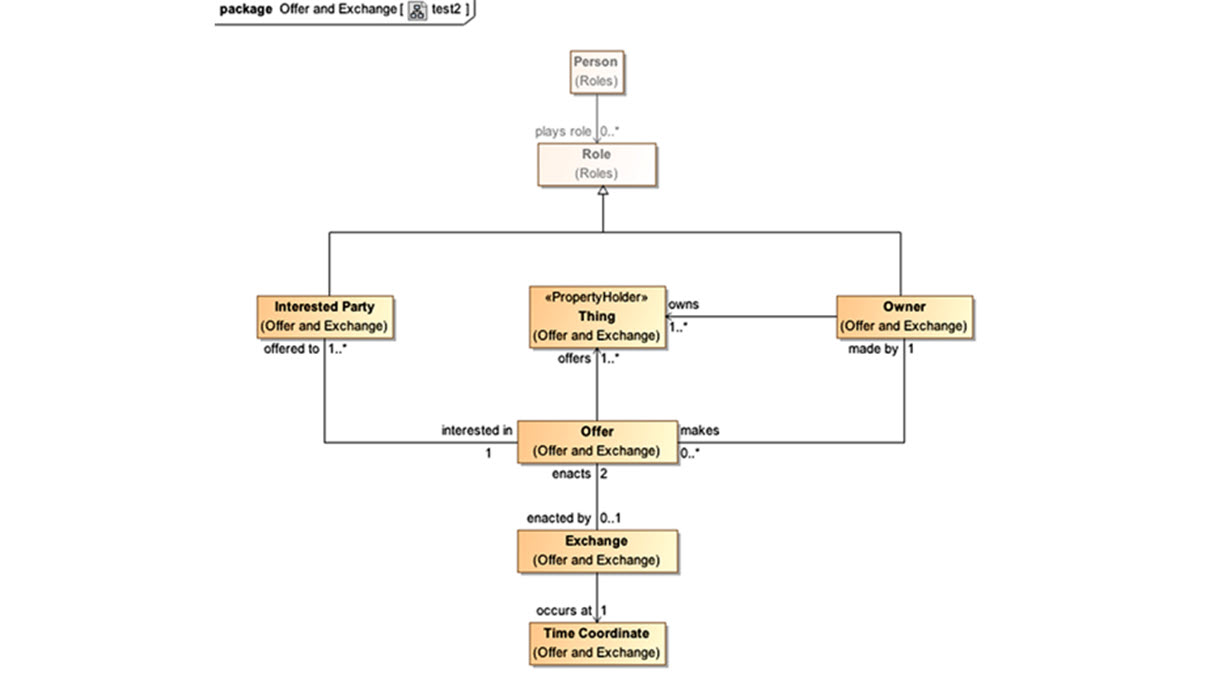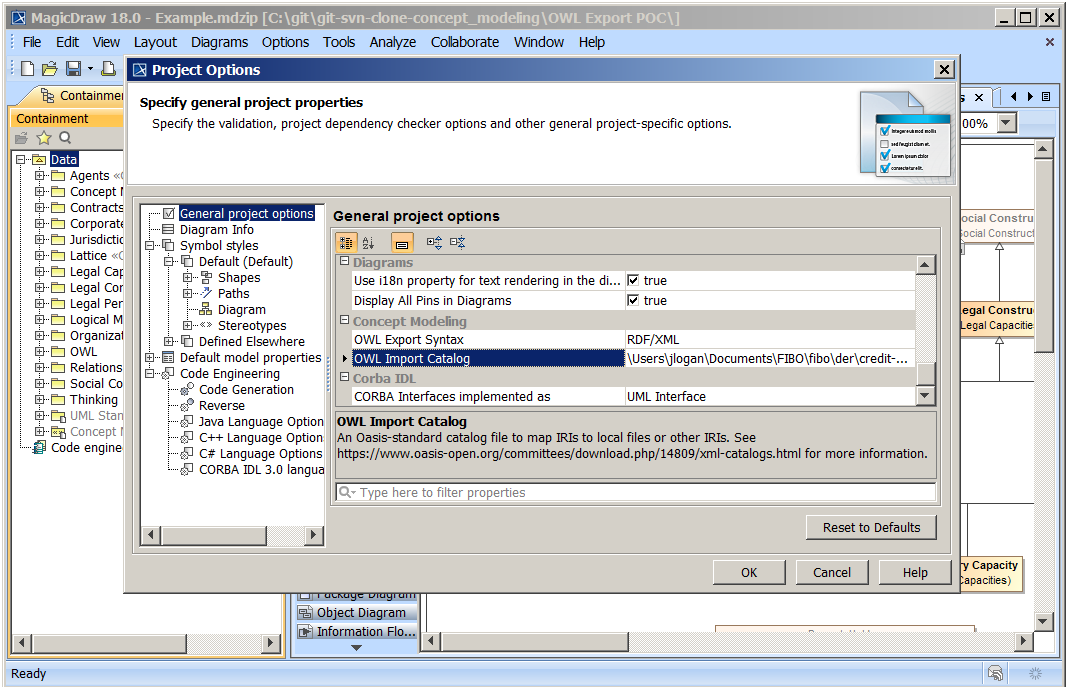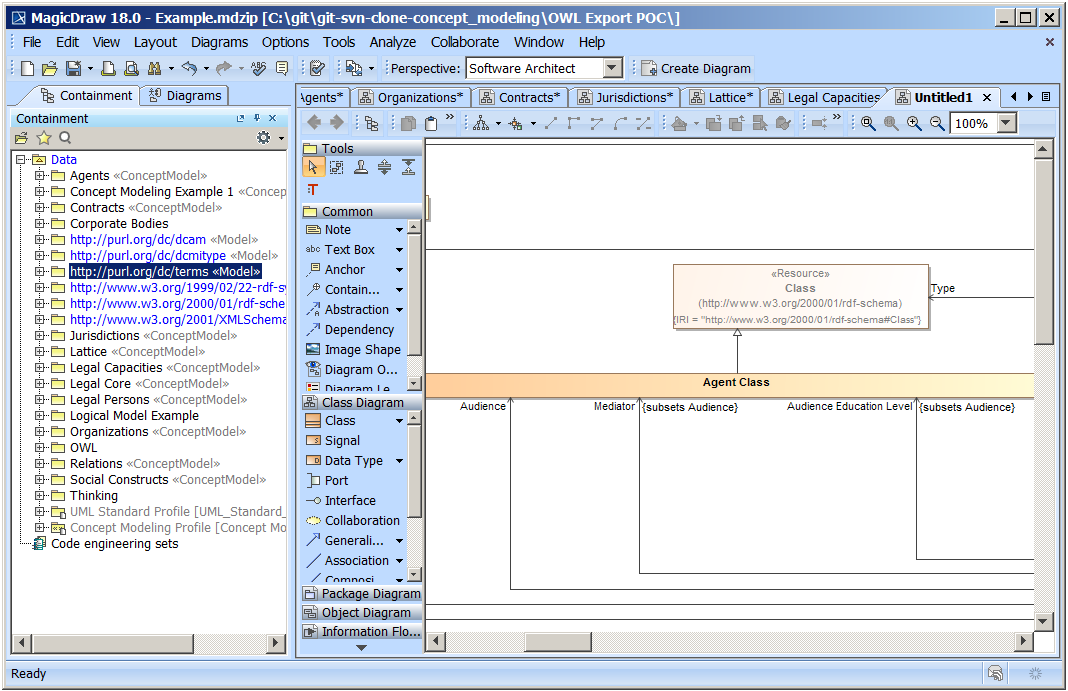Cameo Concept Modeler
Modeling Real-World Concepts
Align Your Systems of People, Processes, and Information
Ontology tools can be a nightmare to look at and difficult to use. And in recent years, the number of available ontologists and data scientists who can tackle these tools hasn't been growing fast enough to meet industry demand. That means many enterprises may be left stranded with disparate systems and misunderstandings between technical and non-technical stakeholders.
Cameo Concept Modeler is the Answer
Introducing Cameo Concept Modeler (CCM), a plugin to the award-winning MagicDraw® platform. By putting a friendly face on the familiar UML 2 standard notation, No Magic brings users an innovative way to model concepts without needing an advanced degree in formal description logic.
Cameo Concept Modeler provides the value of ontologies while hiding the formal model behind its appealing graphics/UI and plain-English glossaries.
Thanks to CCM's intuitive drag-and-drop interface, modelers can create meaningful model elements with a single keystroke. That ease-of-use enables users to focus on the process of developing and analyzing models as they question subject matter experts. And while a model is complete in itself, the generated CCM glossary helps everyone understand the model from multiple perspectives — reducing any misunderstandings across teams.
Cameo Concept Modeler is easy to use and easy to understand.
Cameo Concept Modeler Key Benefits
Enhances the Capability of MagicDraw
With Cameo Concept Modeler, anyone who knows UML can model concepts. Current MagicDraw users can work at full speed in a familiar UML notation. New users can easily learn the ropes, whether they're looking to build their own concept models or simply want to understand ontologies that others have built.
Visualizes Existing Ontologies
Users can leverage their colleagues' models in order to improve their own, or explore ways in which various models interconnect. Cameo Concept Modeler lets all stakeholders understand the model at a glance.
Automatically Generates Plain-English Glossaries
The plain-English glossaries generated from Cameo Concept Modeler are easy to read and understand in day-to-day business. Users can add supplemental definitions such as examples and counter-examples. With Cameo Concept Modeler, users will find that the better the model, the clearer the auto-generated glossary.
Connects To the Semantic Web
Cameo Concept Modeler gives ontologists a new way to connect UML models with the Web Ontology Language (OWL). Users can import from OWL. In addition, they can export to OWL. And in OWL, the models are more precise -– or use a reasoning tool to find any logical inconsistencies.
Defining a Concept Model
- A concept model consists of real-world concepts, not information
- Determines the meaning of fundamental concepts within a domain, and
- Articulates the precise vocabulary needed to communicate efficiently about that domain
A concept model is a model of the real world. That is, it is made up of abstract representations of reality. It does not model information. For example, the information your doctor records about you is not actually you. Concept models help human beings understand how the real world works, regardless of how information about the real world will be stored.
Advantages of Using Cameo Concept Modeler
Users can sketch models on paper, or draw them on a white board. However, there are numerous advantages to using software such as Cameo Concept Modeler to model concepts.
Beyond the typical pros of being able to save, share, and undo model development with the click of a button, using Cameo Concept Modeler that conforms to the UML standard, lets users work with a classic modeling notation that's designed to facilitate understanding. This approach saves the trouble of having to explain personal shorthand when presenting models to colleagues or teams.
The Cameo Concept Modeler takes these advantages one-step further. It enables users to define different model viewpoints, each of which can generate an alternative view of the model depending on the needs of each stakeholder. In other words, users may decide to hide the technical details when presenting to non-technical stakeholders, while showing technical stakeholders all detail.
In Other Words, a Concept Model...
- Doesn't commit to any of the rules that govern the structure of information in a system
- Doesn't have a system perspective, and isn't biased towards a particular solution
Since solutions and system perspectives are geared towards individual systems, they frequently omit concepts that a system doesn't need. Then, those perspectives sometimes merge or approximate the remaining concepts in the rush to meet a system's minimum requirements.
However, the results can be vague, and vagueness does nothing to enrich human understanding. Therefore, a concept model needs to stand apart from all specific solutions. It must strive to include all relevant concepts and to be precise enough to clearly define concepts for all stakeholders.
The Truth is in the Models™ – One Source of Truth
Cameo Concept Modeler enables users to build one all-inclusive concept model to serve as the authoritative source of knowledge for any domain. With all the truth in one place, semantic interoperability between systems becomes possible—meaning that everything and everyone can operate together under one shared understanding of the real world.
Join the conversation in the CATIA MBSE Cyber System User Community!
NOTE: Existing users of No Magic products can access to the user portal at https://magicdraw.com/main.php, as well as Cameo Collaborator for Teamwork Cloud samples at https://ccexamples.nomagic.com.
Learn What CATIA Can Do for You
Speak with a CATIA expert to learn how our solutions enable seamless collaboration and sustainable innovation at organizations of every size.
Get Started
Courses and classes are available for students, academia, professionals and companies. Find the right CATIA training for you.
Get Help
Find information on software & hardware certification, software downloads, user documentation, support contact and services offering



